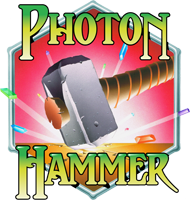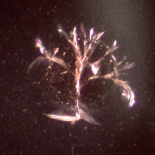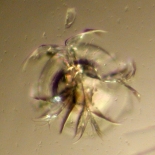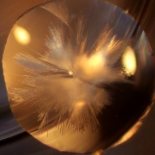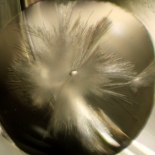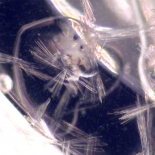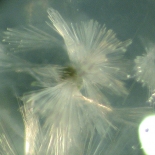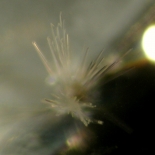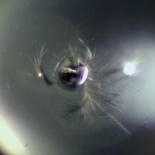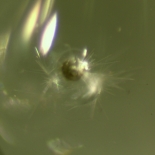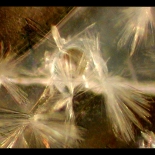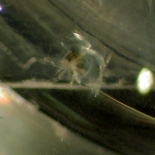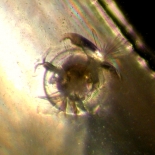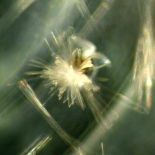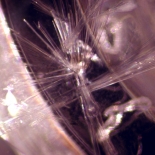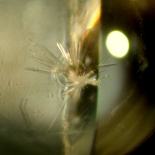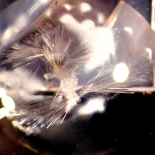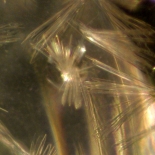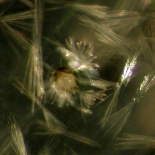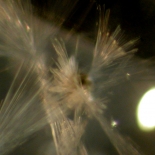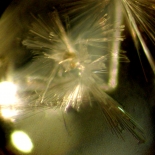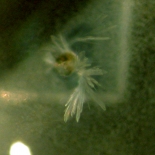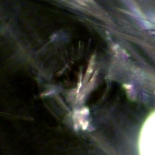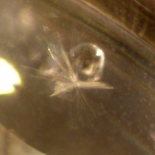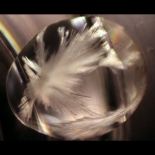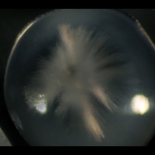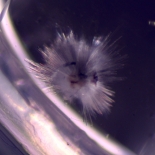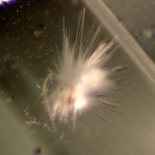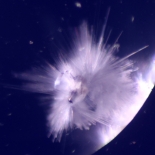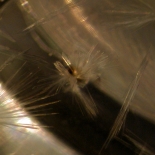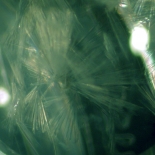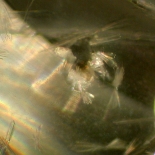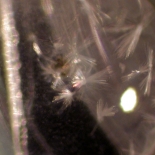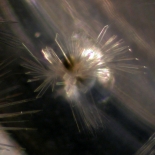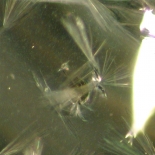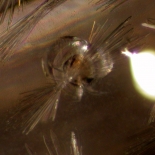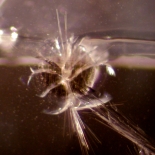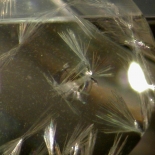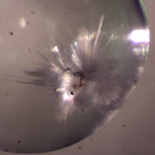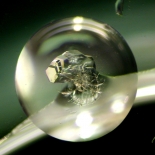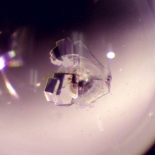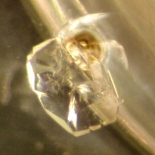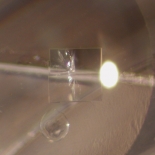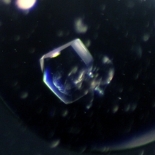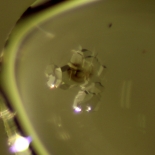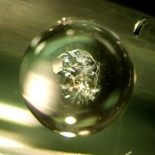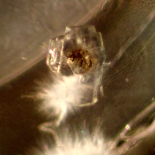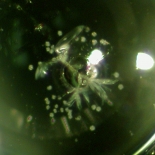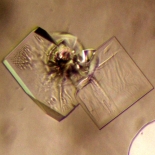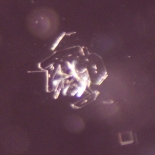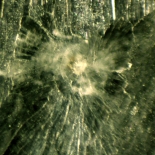
The Image Gallery
Outline of the Image Gallery Content
- Introduction to the Image Gallery
-
Image Gallery 1: Proteins
- Image Group 2: Crystals nucleate and form on the region of the substrate where the HN is physically located and not on other regions of the same substrate
- Image Group 3: Crystals of a different habit or polymorph form in the presence of the HN than in its absence
- Image Group 4: Crystals from in the presence of the heterogeneous nucleant but not in the absence of the nucleant
- Image Group 5: Crystals form faster in the presence of a HN than in its absence
- Image Gallery 2: Inorganic Materials and Small Molecules
General Viewing Instructions for the Image Galleries The images of the crystals below are displayed as thumbnails and are arranged into categories defined by the type of effect the heterogeneous nucleant had on the course of crystallization. By clicking the thumbnail a full-size, high resolution image is displayed in a lightbox.
One general feature that appears in many of the images is the heterogeneous nucleant itself. The central damage zone of the nucleants is typically 50-100µm. As described in the Technical Background section of this website, the Photon Hammer slides are fabricated from glass substrates. In the accompanying images, one can often easily see the heterogeneous nucleant. The heterogeneous nucleant, which is often found at or near the center of the nucleated crystals, may be visually recognized by observing one of more of the following indicators: (a) a round feature with additional concentric damage rings in some cases, (b) cracks, which are most often curved or bent, emanating from the central damage zone as shown in the Technical Background section or (c) a brown coloration due to formation of elemental silicon from the decomposition of the silicate-based glass during laser processing.
Morphology of the Photon Hammer Heterogeneous Nucleants The typical appearance of the laser fabricated heterogeneous nucleants includes one or more circular damage zones from which many cracks emanate. Note that the cracks do not propagate far from the central damage zone as they deflect when encountering the undamaged glass. Since the cracks terminate at some point, the width of the crack at its terminus is zero.
Image.Group.1 The below images show the damage zone formed during the Photon Hammer heterogeneous nucleation fabrication process. The cracks emanate from the damage zone and taper to zero width at the crack terminus.
This Image Gallery contains photomicrographs of crystals of proteins which show various influences and effects which may be attributed to the presence of the Photon Hammer heterogeneous nucleant (HN) during crystallization. The trials involving protein samples used commercially available materials as described below. In the second section of the Image Gallery (Image Gallery 2), there are examples of the crystallization or inorganic materials, salts and small organic molecules further illustrating the general nature of the nucleation phenomena initially observed with proteins. Additional information, including background material and hypotheses regarding the functioning of the Photon Hammer substrates, is available in the Technical Background and White Paper sections of this website. A discussion of the protocols and use of the heterogeneous nucleants may be found at the Photon Hammer Substrates section.
The effects of the Photon Hammer nucleants shown below are remarkable, very strong and reproducible. The efficacy of the nucleant depends strongly on the precise physical form of the nucleant with the exact type of damage incurred during the Photon Hammer process exerting a great influence on the course of nucleation. In all of the cases illustrated below, the protein solution is placed into contact with the Photon Hammer nucleant on a glass substrate usually in a sitting drop crystallization geometry. The negative control refers to the same crystallization trial (often in close proximity to, but not in contact with, the heterogeneous nucleant on the same substrate) performed in the absence of any heterogeneous nucleant (i.e., the “normal” experiment). The negative controls and samples in contact with the nucleants are always taken from the same source solution. In some trials, a second negative control, which was the plastic post of a sitting drop crystallization plate, was used.
A heterogeneous nucleant is generally a solid state material which, when in contact with a solution containing the soluble species to be crystallized, alters the course of crystallization as compared to the course in the absence of the HN. There are many ways, some of which are substantially more useful than others in practice for crystallographers, in which the presence of the heterogeneous nucleant may manifest itself.
- Crystals nucleate and form on the region of the substrate where the HN is physically located and not on other regions of the same substrate
- Crystals of a different habit or polymorph form in the presence of a HN than when the HN is not present
- Crystals from in the presence of the heterogeneous nucleant but not in the absence of the nucleant
- Crystals form faster in the presence of the heterogeneous nucleant than in its absence
- A higher percentage of crystals form in screening trials with a HN than without a HN.
- A heterogeneous nucleant can exert effects over large distances (cm) during the crystallization of bulk samples
- Crystals that have proven difficult or impossible to crystallize more readily in the presence of a HN?
Several of these particular manifestations of heterogeneous nucleation listed above have been observed in trials using the Photon Hammer Substrates (PHS) and these effects will be discussed in relation to their description in the Image Galleries below. Not all of the above criteria were observed with all proteins studied but instances of these heterogeneous nucleation criteria will be illustrated using specific examples. Several proteins tested never crystallized, with or without the HN present, under the conditions used. While there was never a case where the negative controls crystallized and the nucleant samples eventually did not, we observed several instances of the heterogeneous nucleant causing crystallization of a different crystalline habit or polymorph than the negative control - which could form sooner or later than the negative control.
The broad applicability and potentially wide-ranging utility of the Photon Hammer heterogeneous nucleants is illustrated by the strong effects seen when crystallizing non-proteinacious materials such as soluble inorganic salts and small molecules. In the second section of the Image Gallery (Image Gallery 2: Inorganic Salts and Small Molecules), the localized growth of these materials on the nucleants is illustrated.
Another interesting general observation was that within a single crystallization sample, only a single polymorph was observed in the presence of a heterogeneous nucleant; two different crystalline habits within the same sample were never observed when a nucleant was present.
- Crystals nucleate and form on the region of the substrate where the HN is physically located and not on other regions of the same substrate
We have observed hundreds of definitive examples of crystals growing directly on or in close proximity to the damage zone of the heterogeneous nucleant. In most of these cases the crystals nucleated first on the cracks or damage zone of the Photon Hammer substrate and in many cases crystals grew only on the damage zone and not elsewhere on the substrate within the same crystallization drop. When the crystals nucleate and grow directly on the nucleant, the following statements must be true:
- The heterogeneous nucleant initiated and caused the crystallization event
- The crystal nuclei form more quickly within the nucleant than areas of the substrate without nucleants present
- When the crystals form do not form on the corresponding negative control it is not because the conditions in the solution were not favorable for crystal growth but rather there was no rapid pathway to forming crystal nuclei of sufficient size and stability to allow subsequent crystal growth
The fact that crystals are often observed growing directly on the nucleant is consistent with our hypothesis that the cracks and damage within the nucleant facilitate crystal growth by sufficiently reducing the translational motion of the solute to the point where nascent crystalline nuclei form on the surface of the Photon Hammer substrate.
Protein crystals which grow preferentially directly on the nucleants are shown below for the proteins Lipase, Lysozyme and Xylanase.
Image.Group.2 These images show several examples of crystals nucleating and growing directly on the Photon Hammer heterogeneous nucleation site.
Image.Group.2.1 Lipase These images depict Lipase crystals forming directly on the heterogeneous nucleation site.
Image.Group.2.2 Lysozyme These images show Lysozyme crystals growing directly on the heterogeneous nucleation site.
Image.Group.2.3 Xylanase These images illustrate Xylanase crystallizing directly on the heterogeneous nucleation site.
- Crystals of a different habit or polymorph form in the presence of a HN than when the HN is not present
We have discovered many examples which indicate that the Photon Hammer heterogeneous nucleants can prevent the deposition of the normal or typical polymorph from solution. For example, in several systems we have observed that the normal and expected polymorph crystallizes readily without the Photon Hammer Substrate but the samples in the presence of the nucleant only crystallize much later – and when the samples do crystallize they crystallize in a polymorph different than that obtained from the crystallization trial without the Photon Hammer heterogeneous nucleant present. In this section we present three examples: Lysozyme, Catalase and Xylanase where the expected polymorph that crystallizes normally is completely suppressed in the presence of the Photon Hammer nucleant and instead a different polymorph crystallizes exclusively.
Here, the designation of two crystalline forms as different polymorphs is based solely on the visually different habit of the crystals as none of the crystals were characterized by x-ray crystallographic methods.
As a first example, the crystallization of Catalase shows stark and definitive results in terms of differences in the time course of crystallization or the polymorph obtained (see below). A Catalase crystallization trial was performed where 12 substrates were prepared each of which had one negative control (no heterogeneous nucleant) and four heterogeneous nucleants. Five drops of the catalase crystallization solution was placed onto each substrate: one for the negative control and four on the heterogeneous nucleants (for a total of 60 trials) and the plate sealed. Within 12 hours all 12 (100%) of the negative controls had crystallized into relatively large single crystals displaying the distinctive wedge-shape of the Catalase crystals. But none of the 48 protein solution drops in contact with the heterogeneous nucleant had crystallized with 10 days. Then, approximately 10-20 days into the crystallization trials, the solutions in contact with the heterogeneous nucleants began to crystallize - but with a polymorph of a distinctly different square plate habit. Around half of the solutions in contact with the heterogeneous nucleants eventually crystallized. All of the heterogeneously nucleated crystals were of the square plate habit and all of the crystals grown in the absence of nucleants were of the wedge habit. No crystals with the wedge habit were ever observed in the heterogeneously nucleated samples and no crystals with the square plate habit were ever observed in the samples crystallized in the absence of the nucleant.
This suppression of the normal polymorph, and appearance of crystals of a different habit instead, in the presence of the Photon Hammer nucleants has also been observed with Lysozyme. When Lysozyme is crystallized in the absence of the Photon Hammer heterogeneous nucleants it crystallizes in the familiar polyhedral habit with very large, clear single crystals obtained within hours or days. Often only one large single crystal is obtained from a crystallization drop. The growth of few large single crystals is indicative of a crystal growth rate that is much faster than the nucleation rate.
When the same crystallization experiment is performed in the presence of the PH nucleants the polyhedral polymorph is nearly completely suppressed only appearing in around 5-10% of the trials. When the polyhedral crystals did nucleate, they nucleated directly on the nucleants with some visually spectacular results (see below). With the nucleant present, very few polyhedral crystals deposit and usually no other type of crystal forms for several days or weeks. But after this time has elapsed, variable percentages (20-70%) of the lysozyme samples with the nucleant present begin to crystallize - but in a completely different habit which appears as compact tufts of fine needles (see below). When the needle tufts do form, they always nucleate first from the heterogeneous nucleant site.
In a particularly dramatic example of the effect of the nucleant, we observed, on a heterogeneous nucleation substrate with a damage zone the that possessed cracks all the way through the thin (~150µm) glass substrate (from top to bottom surface), one Lysozyme habit on one surface of the substrate and another habit on the other side of the same substrate (see below)!
Although detailed mechanism is still unknown, like the Catalase system above it is clear that the presence of the heterogeneous nucleant strongly hinders the formation of nuclei which lead to crystals of the normal Lysozyme habit but nonetheless allow the subsequent growth of crystals with different habits. The normal habit is suppressed even though it is obvious that the conditions required to quickly form large crystals of the polyhedral habit are present in each drop as judged by the rapid formation of the polyhedral habit (usually hours to <1 day) in the absence of the nucleants.
The crystallization of Xylanase is also strongly influenced by the presence of the Photon Hammer nucleants and once again a normal polymorph is suppressed in favor of crystals of a very different habit. In the Xylanase case, crystallization trials in the presence of the heterogeneous nucleants rapidly yield small, multifaceted mounds of crystals with a distinctive habit (see below) usually with 12 hours after preparation. After observing ~100 trials, these faceted mounds form in essentially 100% of the trials in the presence of the nucleant but have never been observed in sample without the Photon Hammer nucleants.
The suppression or enhancement of one crystal habit over another controlled by the Photon Hammer heterogeneous nucleants seems to a general phenomenon based on its frequency of observation compared to the number of trials. Since the suppression of the typically normal habit is not due to the absence of suitable conditions to deposit crystals it must be attributed to the essentially complete elimination of the nuclei that can grow into the normal polymorph.
Several interesting observations and hypotheses concerning nucleation and crystal growth may be obtained from these experiments.
- The heterogeneous nucleant drastically alters the normal course of crystallization events
- The presence of the Photon Hammer heterogeneous nucleant can completely suppress or substantially delay the formation of the crystalline form consistently and reproducibly seen in the absence of the nucleant
- When the heterogeneous nucleant prevents the normal polymorph from nucleating it is not because suitable crystal growth conditions are not present – it is because the nascent nuclei for the normal polymorph does not form
- The Photon Hammer nucleant causes one polymorph to nucleant in preference to all others under these conditions
- The nucleation mechanism in the same protein growth solutions with and without the nucleants must be different.
It remains unclear how exactly the damaged substrate exerts such a powerful and selective effect on the course of the crystallization.
Image.Group.3 These images illustrate how the Photon Hammer heterogeneous nucleants can (a) completely suppress the normal polymorph which crystallizes readily and quickly in the absence of the heterogeneous nucleant and (b) cause polymorphs to crystallize which are different than those obtained in the absence of the heterogeneous nucleant. Please see text.
Image.Group.3.1 Catalase The images in this section show that all negative controls crystallize within 12-24 hours with a wedge-shaped polymorph while 10-20 days later the samples in contact with the Photon Hammer nucleants crystallize with a distinctive square, platy habit.
Image.Group.3.2 Lysozyme These images depict the difference between the Lysozyme polymorphs obtained in the absence (large polyhedra) and presence (tufts of fine needles) in the presence of the heterogeneous nucleants. Although the polyhedral Lysozyme crystals occasionally form directly on the nucleant (see Image.group.2.2 Lysozyme), the normal course of events is that the large polyhedra form without the nucleant (12-48 hours) while the fine tufts appear (3-10 days) only in samples with the heterogeneous nucleants and only forms directly on the nucleants.
Image.Group.3.3 Xylanase The images, and those images in Image.Group.2.3 Xylanase, show that the normal Xylanase polymorph is suppressed and miniscule, multifaceted mounds crystallize instead.
- Crystals from in the presence of the heterogeneous nucleant but not in the absence of the nucleant
In the examples discussed above, both the negative control (no nucleant) and the Photon Hammer substrates crystallized - albeit in crystals that had different habits. In those examples, both the Lysozyme heterogeneously-nucleated polymorph and the Xylanase heterogeneously-nucleated polymorph both formed directly on the heterogeneous nucleant. However, while the alternative polymorph for Catalase grew only in the samples with the heterogeneous nucleant present, those crystals did not form directly on the nucleant itself. But in all cases crystallization was observed to take place in both the presence and absence of the heterogeneous nucleant.
However, in the case of the protein Lactoalbumin many samples crystallized in the presence of the heterogeneous nucleant but crystallization was never observed in the any of the negative controls under the conditions employed. The Lactoalbumin crystals always formed in clusters of very long thin needles that originated from a single point. Like the Catalase samples discussed above, the Lactoalbumin crystals were never observed to grow directly on the nucleant but rather elsewhere within the crystallization drop. Even after weeks, none of the negative controls ever crystallized.
Image.Group.4 Lactoalbumin The images displayed here show the effect that the Photon Hammer heterogeneous nucleation has on the crystallization of Lactoalbumin. In the presence of the heterogeneous nucleant, clusters of long, thin needles of Lactoalbumin, which always originate from a single common nucleation point, readily crystallize in at least half of the trials. Like Catalase, the Lactoalbumin crystals were never observed to have crystallized directly on the heterogeneous nucleant but rather near the periphery of the crystallization drop. However, identifiable single crystals were never found in the absence of the nucleant in any samples even after many weeks of observation. Only the fine-grained powder (Row 4, Column 2) was observed without the Photon Hammer nucleant. Images Row 5, Columns 2 and 3, show both Lactoalbumin habits within the same image.
- Crystals form faster in the presence of the heterogeneous nucleant than in its absence
One indication of the effect of a heterogeneous nucleant would be acceleration in the rate of crystallization compared to an identical sample with no nucleant present. We have observed that the Photon Hammer heterogeneous nucleants can induce crystallization in samples days or weeks faster than the corresponding samples with no nucleants.
During crystallization trials crystals of Lipase were often observed growing directly from the damage zone of the heterogeneous nucleant as shown and discussed above. When the precipitant and Lipase protein solution were allowed to mix by carefully placing the two drops side by side to facilitate slow mixing, the solutions usually remained clear as the crystals formed and grew. However, if the protein solution and precipitant were thoroughly mixed the solution became turbid and nearly opaque due to the very fine precipitate. When this turbid mixed solution was placed on the substrate, with some samples contacting the heterogeneous nucleants and negative controls not contacting the nucleants, the samples in contact with the Photon Hammer nucleation sites crystallized days to weeks faster than the negative controls.
As shown below, all of the crystallization drops are initially cloudy but the samples with the heterogeneous nucleants present within the drop begin to clarify and soon crystals begin to emerge from the haze and become apparent (see below). It is seen that the samples become clearer as the crystals deposit and it is apparent that the crystals are growing directly from the heterogeneous nucleation sites. Over several days the four heterogeneous nucleation samples continue to clarify and there is a trend showing that the larger the area of the nucleant the faster that sample crystallizes and clarifies. Eventually, when the heterogeneously nucleated samples have finished crystallizing and the crystallization drops have completely clarified, the negative controls begin to crystallize.
It is clear from these results that Photon Hammer heterogeneous nucleants can greatly accelerate the rate at which a compound crystallizes. Since the Lipase solutions with and without nucleants are identical, the increase in crystal growth rate is solely attributable to an increase in the nucleation rate and efficacy when the heterogeneous nucleants are present.
Image.Group.5 These images show the acceleration on the crystallization rate of lipase in the presence of the Photon Hammer heterogeneous nucleants. Most of these experiments have five samples per substrate with four crystallizations trials with the heterogeneous nucleants present surrounding a single negative control experiment. The samples are all initially cloudy and turbid (Row1-Column 1, Row 4-Columns 2-4 and Row 5- Columns 1 and 2) but within 1-2 days the samples with the heterogeneous nucleants present begin to become clearer and crystals begin to emerge from the haze (Row 1-Columns 2-4, Row 2-Columns 1-4, Row 3-Columns 1-4 and Row 4-Column 1). Close-up images shown emerging from the turbid drops in Row 1-Column 1 are shown in Row 1-Column 4 and Row 2-Columns 1-3. The image in Row 2 –Column 4 is the negative control which does not crystallize until 2-3 weeks later if at all. Within a few more days the heterogeneous nucleation samples have clarified still further and the crystals are easily visible (Row 3-Column 1). After 3-10 days the samples containing the heterogeneous nucleants have completely crystallized and crystallization of the negative finally begins and is complete some days later. In some case, the negative controls never crystallize.
- A higher percentage of crystals form in screening trials with a HN than without a HN.
If a given protein has never been crystallized then an approach using a sparse screening matric with a large amount of compositional variation among the screening buffers is often employed. Since there is a likely correlation between the efficacy of the heterogeneous nucleant and the rate at which a protein crystallizes, we used the Xylanase samples to investigate the comparison between the screening results with and without a heterogeneous nucleant present because the crystallized more quickly than other proteins.
When Xylanase was used in a sparse matrix screen with 48 different buffers (two samples and two negative controls for each of the 48 buffers) about 34 of the samples formed the Xylanase crystals shown above but only 6 of the negative controls crystallized after 12 hours. And about 45 samples and 25 negative controls crystallized after 2 weeks.
Image Gallery 1: Summary It is clear from the above images and the discussion that the heterogeneous nucleants prepared using Parallel’s Photon Hammer fabrication technology can have pronounced, varied, surprising, reproducible and useful effects on the course of nucleating and growing protein crystals. Given the relative small number of proteins investigated a particularly diverse array of effects were observed including acceleration of crystal growth, suppression of normal polymorphs, increased hit rates in sparse matrix screening experiments, the crystallization of atypical polymorphs and the preferential nucleation of crystals directly on the heterogeneous nucleation site. Perhaps the most surprising observation is the degree to which the Photon Hammer nucleant allows only one type of nucleus to form to the exclusion of all other including nuclei that readily and rapidly form from the same solution in the absence of the nucleant.
In the Technical Background and White Paper sections of this website we proffered hypotheses that the cracks and crevices produced during the Photon Hammer fabrication process provided a more efficient means than a flat surface or debris-based nucleants to decrease the translational energy of the solute molecules when they are absorbed into the cracks. If the hypothesis is valid, and since the cracks terminate within the Photon Hammer laser damage zone, each nucleant should cracks of widths and dimensions small enough to order any solute molecules no matter what their size. The Photon Hammer nucleants also act as potent nucleating agents for salts, soluble inorganic materials and small organic molecules as the images below demonstrate.
The images below show a large number of inorganic materials growing directly on the Photon Hammer heterogeneous nucleant. It is clear, as was the case with the protein crystallization trials, that these nucleants also can initiate and influence the nucleation and crystal growth of a large variety of non-proteinacious materials. It is apparent that the crystallization of inorganic materials is likewise strongly influenced by the Photon Hammer nucleants.
- A heterogeneous nucleant can exert effects over large distances (cm) during the crystallization of bulk samples
Even though the heterogeneous nucleants prepared via the Photon Hammer technology are generally <100µ in size the nucleant can initiate effects that are seen over much larger distances. Among the examples below, the crystallization of the small organic molecule benzamidine shows the 100µ-sized nucleant altering the crystal growth on length scales >7mm.
